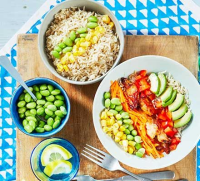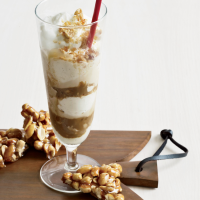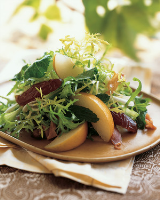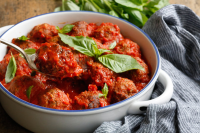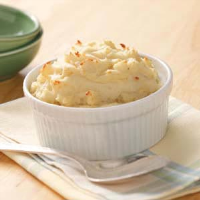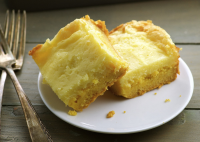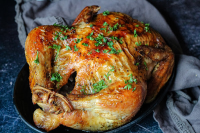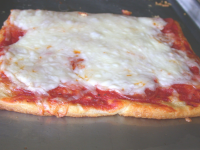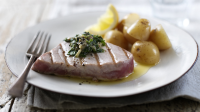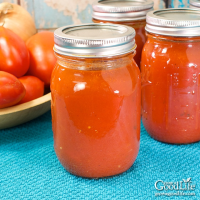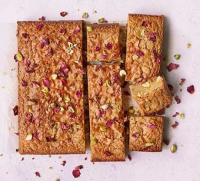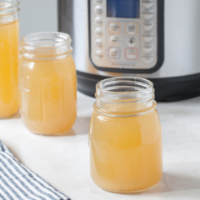PASTELES RECIPE - NYT COOKING
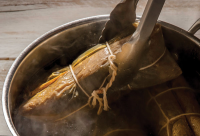
Most of the components for pasteles, a traditional Puerto Rican holiday dish, can be made a day or two in advance, then brought to room temperature for assembly. You can prepare the masa ahead, and freeze it for up to several months. Pasteles can also be cooked right away, refrigerated for a few days or frozen in zip-top containers for several months. Some use only green bananas or green plantains – which are unripe, firm and very green – for the masa; some add potatoes or pumpkin; some add yuca, also known as cassava, and others use only yuca. If you can’t find one or more ingredients, use what you can find. Lucy Ramirez adds pork gravy to the masa (other cooks may add milk or oil) and makes sure there’s a little pork in every bite of the pastel. Traditionally, pasteles were fully wrapped in banana or plantain leaves before being wrapped in parchment paper or foil. Today, many cooks use a piece or strip of banana leaf to give each pastel the nutty flavor of the leaf. Serve them with a side of hot sauce or ketchup. Click here to learn how to assemble the pasteles.
Provided by Rachel Wharton
Total Time 4 hours
Yield 36 pasteles, or 18 pairs
Number Of Ingredients 23
Steps:
- Make the sofrito: Place the chiles, bell peppers, onions, culantro, cilantro, garlic and pimentos in a blender and process until the mixture is fully puréed, scraping the sides of the blender as needed. Refrigerate until ready to use: This can be made up to 3 days in advance and refrigerated.
- Make the masa: Peel the bananas and plantains: Prepare a mixing bowl or large pot with water. Cut off the ends of the fruits, then use a knife to score and peel off the skin. Place the bananas in the bowl of water as you go so they don’t discolor. (The skins can stain, so be careful as you handle them, or wear plastic gloves.) Remove the skin of the yautia with a vegetable peeler and add it to the water.
- Remove the bananas, plantains and yautia from the water and process until smooth: First, in a food processor fitted with the grating disc, shred each ingredient separately, dumping them into a large bowl as you go. Mix the ingredients together in the bowl, switch to the blade fitting, and process the mixture in batches until smooth, stopping to scrape down the sides of the work bowl as necessary. The end result should look soft and fluffy like a purée. (Alternatively, you can grate everything by hand on the smallest holes of a box grater.) Transfer the masa to a large mixing bowl. At this point it can be refrigerated for a few hours, covered, while you prepare the pork, or frozen for up to 3 months.
- Prepare the pork: Cut the pork into small, rough chunks about 1 inch long by 1/2 inch wide, trimming away excess tough fat as you go. Place the pork pieces in a large stockpot or Dutch oven over medium-high heat. Stir in the reserved sofrito, making sure all of the pork cubes are coated. Let the pork cook, stirring almost constantly, until it starts to release some liquid, about 5 minutes. Add the olive oil and let it cook for a minute or two, then stir in the seasoning packet.
- Let the pork cook for another minute or two, then stir in the olives and their brine, the tomato sauce and the chicken stock or water, and a pinch of salt. Let the liquid come up to a simmer, then cover the pot and reduce the heat. Let the pork cook at a simmer for 30 minutes, or until the meat is cooked through, stirring occasionally. There should be plenty of liquid in the pot at all times, so the mixture looks like soup, not stew. If it looks dry, add stock or water as needed.
- While the pork cooks, make the annatto oil: In a small saucepan, heat the oil and the annatto seeds over medium-high heat, stirring occasionally, until the oil begins to bubble. Lower the heat slightly and let the seeds cook in the oil until the liquid turns a bright pink-red. Turn off the heat and let the seeds sit in the oil until it cools. Strain the oil through a sieve or slotted spoon into a small mixing bowl, discarding the seeds. Set the bowl aside. (If the liquid does not immediately begin to turn red, your annatto seeds are too old.)
- When the pork is done, taste for seasoning, and add more salt if desired, then turn off the heat. Take 2 to 3 cups of the liquid from the pork and stir it into the masa until it is the consistency of thick oatmeal, soft but spreadable. You will still need about 2 to 3 cups of liquid to make the pasteles, so if your pot looks dry at this point, stir in a little water or stock so that you still have plenty of liquid, and taste for seasoning again.
- On a large, clean work surface, set up your pastel-making station: You will need the banana leaves, parchment paper, string, the annatto oil, the pork and its liquid, and the masa. To make each pastel, start with a piece of parchment paper in front of you, one long side closest to you. Use a soup spoon or a pastry brush to paint a very thin smear of annatto oil on the parchment paper, leaving a 2-inch border on the top and bottom and 4 inches on the sides. (This does not have to be perfect: It’s just to keep the banana leaf from sticking.) Lay the banana leaf down on top of the oil, long side closest to you. Paint the banana leaf very lightly with the annatto oil. Spread 1/2 cup of masa on top of the banana leaf about 3/4 to 1/2 inch thick. The masa does not have to be a perfect shape: It can overlap the leaf in places and does not have to cover it completely.
- Spoon a scant 1/4 cup of pork pieces along the length of the masa in a straight line. Your goal is really a line of pork chunks along the center of the masa, so that each bite of pastel has a bite of pork. Add 2 olives to the masa, one near each end. Use a spoon to drizzle on a little more liquid as needed so that most of the masa is covered by a very thin layer of liquid. Don’t overdo it: About a tablespoon or so of liquid per pastel is about right.
- To form the pastel, fold the parchment paper in half, from the bottom up, over the masa and filling so the 2 long edges meet. Fold those edges down to meet the edge of the pastel farthest from you. Press the paper down and crease the top edge. Fold the parchment in half again lengthwise from the top down, so it covers the pastel. You now have a long thin pastel wrapped in a tube of parchment, with multiple layers of paper on top. (This needn't be exact, as long as the paper forms a neat little package.)
- Working carefully, use the side of your hand to press and slide the masa on either side of the package into the center to give it a neat edge. Fold in 1 inch of the paper on the left and right sides to create small hems. Then fold both sides over the pastel. (If you have a few leaks, it’s O.K.)
- Set this pastel aside, flaps facing downward, while you make its partner: Repeat the process above to make a second pastel.
- When you have 2 pasteles, stack them together so they line up, flaps facing inward. Use 1 piece of string to tie the pasteles together the same way you would a package, looping the string once across the long way and at least once across the short way. Make sure the string is tight and the pasteles are tightly tied together. Repeat this process with the remaining pairs of pasteles. At this point they can be frozen for several months, refrigerated for a day or two, or cooked and eaten immediately.
- To cook them, bring a large pot (or a few pots) of salted water to a boil and add the pasteles, either fresh or frozen, in a single layer. Let cook for 1 hour, or an hour and 10 minutes or so if they are frozen. Repeat with the remaining pasteles, then unwrap and serve right away.
PASTELóN RECIPE - NYT COOKING
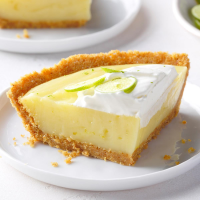
Pastelón is a layered Puerto Rican casserole of plantains, cheese and picadillo, a tomato-based ground beef mixture seasoned with onions, peppers, herbs and spices. The dish is often referred to as Puerto Rican lasagna, and to say there is only one real recipe for pastelón would be like saying there’s only one true lasagna. Variations abound! Some cooks boil the plantains and make a mash with taro; others fry them until they’re sweet and crisp. Nearly any mild, meltable cheese may be used, though there is debate over whether or not to add raisins. This recipe is adapted from from Natalia Vallejo, chef and owner of Cocina al Fondo in Santurce, Puerto Rico. She doesn’t serve pastelón at her restaurant, but she grew up eating it. Her version includes fried plantains, mozzarella, fresh tomatoes and raisins, because she says “Puerto Ricans like that sweet-and-salty mix.”
Provided by Daniela Galarza
Total Time 2 hours
Yield 10 to 12 servings
Number Of Ingredients 25
Steps:
- Prepare the plantains: Line a sheet pan with paper towels; set aside. Cut off the ends of each plantain. With the tip of a knife, score plantains lengthwise and peel off the skin. Using a serrated knife or chef’s knife, cut each plantain in half lengthwise, and then halve again lengthwise so you end up with 24 long slices. (If some of the slices break or are unevenly shaped, that’s OK! Carry on.)
- In a large cast-iron or heavy skillet, heat 1 cup oil over medium-high to between 350 and 375 degrees. Working with 4 to 6 slices at a time, depending on what fits, fry plantains until deep golden brown, turning halfway through, about 6 minutes total. Transfer fried plantains to the prepared sheet pan and cook remaining plantains; set aside. (Let oil cool, then strain and reserve for another use.)
- Prepare the sofrito: Put onion, bell pepper, ají dulce chiles (if using), garlic, cilantro and culantro (if using), in a food processor; blend until it becomes a rough, wet purée. (You should have about 1 cup sofrito).
- Prepare the picadillo: In a large, heavy skillet, heat 2 tablespoons oil over medium until it shimmers. Add the sofrito and cook, stirring often, until purée thickens and starts to brown, about 5 minutes. Add the beef and stir in the salt, pepper, cumin, paprika and oregano. Cook, stirring occasionally, until beef is evenly cooked and no longer pink, about 8 minutes. Turn off heat. Push meat mixture to one side, and carefully tilt skillet so that the fat from the meat collects at the bottom of the tilted pan; spoon off and discard as much of this excess fat as you can.
- Return the skillet to medium heat. Add the chopped tomatoes, wine and tomato paste and cook, stirring occasionally, until tomatoes fall apart and the liquid starts to reduce, about 10 minutes. Turn off heat and stir in olives and raisins, if using. Season to taste with salt and pepper. (Picadillo can be made up to 2 days in advance. Rewarm it in a pan on the stove before proceeding with recipe.)
- Prepare the pastelón: Heat the oven to 350 degrees. Grease a 9-by-13-inch glass baking dish with butter. Whisk the eggs with a pinch of salt and set aside.
- Lay half the fried plantain slices along the bottom of the baking dish crosswise, piecing any broken pieces together to form an even layer. (If there are small gaps in the plantain layer, this is OK.) Top with half the picadillo (about 2 cups), smoothing it into an even layer, then sprinkle half the cheese on top in an even layer. Repeat with another layer of plantains then the remaining picadillo. Pour the whisked eggs evenly over the picadillo layer and spread it so it settles down into the pastelón. Sprinkle the remaining cheese on top.
- Bake the pastelón until the egg is cooked, the cheese is melted and the layers are set, 20 to 30 minutes. Cut into squares and serve hot.
More about "pastel recipe puerto rican recipes"
PASTELóN RECIPE - NYT COOKING
Pastelón is a layered Puerto Rican casserole of plantains, cheese and picadillo, a tomato-based ground beef mixture seasoned with onions, peppers, herbs and spices. The dish is often referred to as Puerto Rican lasagna, and to say there is only one real recipe for pastelón would be like saying there’s only one true lasagna. Variations abound! Some cooks boil the plantains and make a mash with taro; others fry them until they’re sweet and crisp. Nearly any mild, meltable cheese may be used, though there is debate over whether or not to add raisins. This recipe is adapted from from Natalia Vallejo, chef and owner of Cocina al Fondo in Santurce, Puerto Rico. She doesn’t serve pastelón at her restaurant, but she grew up eating it. Her version includes fried plantains, mozzarella, fresh tomatoes and raisins, because she says “Puerto Ricans like that sweet-and-salty mix.”
From cooking.nytimes.com
Reviews 4
Total Time 2 hours
Cuisine american
From cooking.nytimes.com
Reviews 4
Total Time 2 hours
Cuisine american
- Bake the pastelón until the egg is cooked, the cheese is melted and the layers are set, 20 to 30 minutes. Cut into squares and serve hot.
See details
TRADITIONAL PUERTO RICAN PASTELES RECIPE - THE SPRUCE …
Dec 03, 2021 · Making and serving pasteles at Christmas time is a Puerto Rican tradition. Pasteles are made with pork and adobo stuffing encased in a green plantain masa and wrapped in …
From thespruceeats.com
From thespruceeats.com
See details
BEST PUERTO RICAN EMPANADAS - BEST BEEF RECIPES
Jan 23, 2022 · Best Beef Empanadas Recipe. We love Puerto Rican recipes, and this dish has to be our favorite. Using homemade dough or Goya empanada shells, you can make the most delicious meal! Puerto Rican …
From bestbeefrecipes.com
From bestbeefrecipes.com
See details
PASTELóN (PUERTO RICAN PLANTAIN "LASAGNA") RECIPE
May 26, 2021 · Pastelón (Puerto Rican Plantain "Lasagna") Pastelón is a classic Puerto Rican dish made with layers of thinly-sliced plantains, ground beef, and cheese! Think of it as a Puerto Rican …
From simplyrecipes.com
From simplyrecipes.com
See details
40 DELICIOUS PUERTO RICAN RECIPES - MAMASLATINAS.COM
Jul 10, 2018 · From mofongo to alcapurrias, Puerto Rican recipes offer something for everyone. Having traveled to La Isla del Encanto on several occasions, I've been lucky enough to try many of the island's dishes--and I've never been disappointed. In fact, one of the best -- if not the best -- fried fish dishes I've ever had was in Luquillo, Puerto …
From mamaslatinas.com
From mamaslatinas.com
See details
PASTELON (PUERTO RICAN LAYERED CASSEROLE) RECIPE | ALLRECIPES
Pastelon is a traditional Puerto Rican recipe for a layered casserole that delivers a unique blend of salty, sweet, and savory in each bite. ... and banchan side dishes such as kimchi or assorted pickles. Scroll through for our best Korean barbeque recipes…
From allrecipes.com
From allrecipes.com
See details
PASTELILLOS DE CARNE (PUERTO RICAN TURNOVERS) | PASTELILLO ...
Jan 27, 2021 · Pastelillos de Carne (Puerto Rico Meat Turnovers) | When I was in college I road several pisicorre or pisa y corre (passenger van buses) to get from my home in the country to my …
From thenoshery.com
From thenoshery.com
See details
PASTELES DE MASA - A PUERTO RICAN CHRISTMAS TRADITION
Pasteles de Masa | There are three things you must have on the table for a proper Puerto Rican Christmas pernil, arroz con gandules, and pasteles!This post is all about pasteles, the most …
From thenoshery.com
From thenoshery.com
See details
CAZUELA - WIKIPEDIA
Puerto Rican cazuela. In Puerto Rico, cazuela is a traditional crustless pie cooked in banana leaves usually made during the Christmas season. It is similar to a pumpkin pie but uses batata (a …
From en.m.wikipedia.org
From en.m.wikipedia.org
See details
CAZUELA - WIKIPEDIA
Puerto Rican cazuela. In Puerto Rico, cazuela is a traditional crustless pie cooked in banana leaves usually made during the Christmas season. It is similar to a pumpkin pie but uses batata (a …
From en.m.wikipedia.org
From en.m.wikipedia.org
See details
16 CARIBBEAN DESSERT RECIPES - THE SPRUCE EATS
May 04, 2021 · The Spruce / Julia Hartbeck. Just four simple ingredients are needed to make this silky smooth and creamy coconut pudding.Especially popular in Puerto Rico, tembleque …
From thespruceeats.com
From thespruceeats.com
See details
A SASSY SPOON - CUBAN INSPIRED RECIPES
Cuban food is a rich, hearty melting pot of Spanish, African, and other Caribbean cuisines. The majority of recipes are slow-cooked, sautéed, and/or tomato-based with spices like cumin, oregano, …
From asassyspoon.com
From asassyspoon.com
See details
10 BEST VIENNA SAUSAGE RECIPES - YUMMLY
Mar 02, 2022 · Rice Cooker Puerto Rican Beans My Stay At Home Adventures. basil, olive oil, pepper, tomato sauce, stewed tomatoes, chicken and 11 more ... Chicken Pastel Salu Salo Recipes. chicken thighs, light sour cream, olive oil, lemon juice, carrot and 11 more. ... Embutido Recipe …
From yummly.com
From yummly.com
See details
DUMPLING - WIKIPEDIA
Dumpling is a broad class of dishes that consist of pieces of dough (made from a variety of starch sources) wrapped around a filling, or of dough with no filling. The dough can be based on bread, …
From en.m.wikipedia.org
From en.m.wikipedia.org
See details
NESCAFÉ CLÁSICO INSTANT COFFEE | NESCAFÉ®
100% pure coffee beans are carefully roasted to capture their full flavor and aroma, bringing bold Latin flavors to …
From nescafe.com
From nescafe.com
See details
OUR RECIPES | NESTLÉ® TOLL HOUSE® - VERY BEST BAKING
We are true, since the first chocolate chip cookie in the 1930s through decades of inspired baking. Find your new favorite recipe …
From verybestbaking.com
From verybestbaking.com
See details
BROWNIE AND BLONDIE RECIPES | NESTLÉ ... - VERY BEST BAKING
NESTLÉ® Very Best Baking has a sweet for every tooth! Find a new favorite brownie or blondies recipe, perfect for any occasion. See you in the kitchen!
From verybestbaking.com
From verybestbaking.com
See details
CARB CONSCIOUS FROZEN MEALS| LEAN CUISINE® - GOODNES
Manage mealtime and net carbs deliciously with crave-worthy entrées. All 400 calories or less with 30 grams of …
From goodnes.com
From goodnes.com
See details
RECETAS DE PUERTO RICO, PUERTO RICO ... - ELCOLMADITO.COM
Recetas de Puerto Rico, Puerto Rico Recetas Puertorriqueñas Send us your Recipe - Envie su receta …
From elcolmadito.com
From elcolmadito.com
See details
RECIPES - REALCALIFORNIAMILK.COM
Pastel de Piña con Crema/Pineapple and Cream Cake. Peach Pecan Ice Cream Tart. ... Puerto Rican Pastelón. Pumpkin Custards. Pumpkin Gingerbread Trifle. Pumpkin Ice Cream Pie. ... Get inspired with these recipes …
From realcaliforniamilk.com
From realcaliforniamilk.com
See details
BROWSE ALL LA LECHERA RECIPES | OFFICIAL LA LECHERA®
Browse our recipes to find signature desserts or discover something new. Enrich your desserts and make yummy waffles with our mouthwatering flavors! ... Recipe Type . Fruit Salad (11) Cupcakes (6) Pancakes (5) Smoothies (10) Bread (15) Tres Leches (6) Flan (26) All Drinks (33) Pies & Tarts (30) All Occasions (87) Everyday Recipes …
From goodnes.com
From goodnes.com
See details
FOODDATA CENTRAL
The .gov means it’s official. Federal government websites always use a .gov or .mil domain. Before sharing sensitive information online, make sure you’re on a .gov or .mil site by inspecting your …
From fdc.nal.usda.gov
From fdc.nal.usda.gov
See details
OUR RECIPES | NESTLÉ® TOLL HOUSE® - VERY BEST BAKING
We are true, since the first chocolate chip cookie in the 1930s through decades of inspired baking. Find your new favorite recipe …
From verybestbaking.com
From verybestbaking.com
See details
BROWNIE AND BLONDIE RECIPES | NESTLÉ ... - VERY BEST BAKING
NESTLÉ® Very Best Baking has a sweet for every tooth! Find a new favorite brownie or blondies recipe, perfect for any occasion. See you in the kitchen!
From verybestbaking.com
From verybestbaking.com
See details
CARB CONSCIOUS FROZEN MEALS| LEAN CUISINE® - GOODNES
Manage mealtime and net carbs deliciously with crave-worthy entrées. All 400 calories or less with 30 grams of …
From goodnes.com
From goodnes.com
See details
RECETAS DE PUERTO RICO, PUERTO RICO ... - ELCOLMADITO.COM
Recetas de Puerto Rico, Puerto Rico Recetas Puertorriqueñas Send us your Recipe - Envie su receta …
From elcolmadito.com
From elcolmadito.com
See details
RECIPES - REALCALIFORNIAMILK.COM
Pastel de Piña con Crema/Pineapple and Cream Cake. Peach Pecan Ice Cream Tart. ... Puerto Rican Pastelón. Pumpkin Custards. Pumpkin Gingerbread Trifle. Pumpkin Ice Cream Pie. ... Get inspired with these recipes …
From realcaliforniamilk.com
From realcaliforniamilk.com
See details
BROWSE ALL LA LECHERA RECIPES | OFFICIAL LA LECHERA®
Browse our recipes to find signature desserts or discover something new. Enrich your desserts and make yummy waffles with our mouthwatering flavors! ... Recipe Type . Fruit Salad (11) Cupcakes (6) Pancakes (5) Smoothies (10) Bread (15) Tres Leches (6) Flan (26) All Drinks (33) Pies & Tarts (30) All Occasions (87) Everyday Recipes …
From goodnes.com
From goodnes.com
See details
FOODDATA CENTRAL
The .gov means it’s official. Federal government websites always use a .gov or .mil domain. Before sharing sensitive information online, make sure you’re on a .gov or .mil site by inspecting your …
From fdc.nal.usda.gov
From fdc.nal.usda.gov
See details
LIVEINTERNET @ СТАТИСТИКА И ДНЕВНИКИ, ПОЧТА И ПОИСК
We would like to show you a description here but the site won’t allow us.
From liveinternet.ru
From liveinternet.ru
See details















